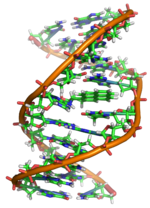A carcinogen (/kɑːrˈsɪnədʒən/) is any agent that promotes the development of cancer. Carcinogens can include synthetic chemicals, naturally occurring substances...
45 KB (4,577 words) - 18:32, 18 September 2024
IARC group 1 Carcinogens are substances, chemical mixtures, and exposure circumstances which have been classified as carcinogenic to humans by the International...
12 KB (1,206 words) - 16:05, 28 August 2024
established itself), there is some evidence that bacteria may be directly carcinogenic. Evidence has shown that a specific stage in cancer can be associated...
26 KB (2,641 words) - 00:05, 1 August 2024
Carcinogenic parasites are parasitic organisms that depend on other organisms (called hosts) for their survival, and cause cancer in such hosts. Three...
20 KB (2,277 words) - 13:40, 15 April 2024
A co-carcinogen is a chemical that promotes the effects of a carcinogen in the production of cancer. Usually, the term is used to refer to chemicals that...
10 KB (1,188 words) - 12:36, 12 July 2024
The safe handling of carcinogens is the handling of cancer causing substances in a safe and responsible manner. Carcinogens are defined as 'a substance...
8 KB (930 words) - 22:16, 1 October 2023
Occupational cancer (redirect from Occupational carcinogen)
cancer-causing chemicals (carcinogens) may cause mutations that allow cells to grow out of control, causing cancer. Carcinogens in the workplace may include...
18 KB (1,616 words) - 12:37, 12 September 2024
IARC group 2B (redirect from IARC Group 2B carcinogen)
exposure circumstances are those that have been classified as "possibly carcinogenic to humans" by the International Agency for Research on Cancer (IARC)...
15 KB (1,444 words) - 16:05, 28 August 2024
Anticarcinogen (redirect from Anti-carcinogenic)
carcinopreventive agent) is a substance that counteracts the effects of a carcinogen or inhibits the development of cancer. Anticarcinogens are different from...
2 KB (174 words) - 14:54, 29 November 2021
Cooking (redirect from Carcinogens in cooked food)
avoidable by changes to the diet. Some of these cancers may be caused by carcinogens in food generated during the cooking process, although it is often difficult...
46 KB (4,963 words) - 03:56, 28 September 2024
IARC group 2A (redirect from IARC Group 2A carcinogen)
carcinogens by the International Agency for Research on Cancer (IARC). This designation is applied when there is limited evidence of carcinogenicity in...
8 KB (748 words) - 16:05, 28 August 2024
occurrence of cancer worldwide. Its IARC monographs programme identifies carcinogenic hazards and evaluates environmental causes of cancer in humans. IARC...
29 KB (3,039 words) - 05:57, 9 September 2024
IARC group 3 (redirect from IARC Group 3 carcinogen)
circumstances are those that can not be classified in regard to their carcinogenicity to humans by the International Agency for Research on Cancer (IARC)...
17 KB (1,518 words) - 16:05, 28 August 2024
Decemberunderground (redirect from Carcinogen Crush)
originally planned for December 2007, but which never materialized. "Carcinogen Crush", written by Burgan, was first recorded during the Sing the Sorrow...
37 KB (2,728 words) - 20:19, 8 July 2024
DNA adduct (section Carcinogens' impact)
an organism's exposure to a carcinogen. The presence of such an adduct indicates prior exposure to a potential carcinogen, but it does not necessarily...
18 KB (2,202 words) - 11:50, 26 August 2024
Acrylamide (category IARC Group 2A carcinogens)
following its discovery in 2002, and its classification as a probable carcinogen, acrylamide from diet is thought unlikely to cause cancer in humans; Cancer...
22 KB (2,035 words) - 08:58, 3 September 2024
Formaldehyde (category IARC Group 1 carcinogens)
Small amounts also occur naturally. Formaldehyde is classified as a carcinogen and can cause respiratory and skin irritation upon exposure. Formaldehyde...
89 KB (8,277 words) - 21:01, 27 September 2024
carcinogen in the United States Environmental Protection Agency Office of Pesticide Programs carcinogen list with a rating of C (possible carcinogen)...
4 KB (198 words) - 17:45, 7 September 2024
platinum-based compounds are carcinogens that increase the risk of secondary cancers Azathioprine, an immunosuppressive medication, is a carcinogen that can cause primary...
186 KB (20,063 words) - 04:18, 16 September 2024
National Toxicology Program (redirect from Office of the Report on Carcinogens)
at 42 U.S.C. 285l-3) 1st Report on Carcinogens. 1980. 15th Report on Carcinogens. 2021. "14th Report on Carcinogens". National Toxicology Program. Retrieved...
7 KB (578 words) - 14:02, 31 January 2024
Oncovirus (redirect from Viral carcinogen)
and Kaposi's sarcoma-associated herpesvirus). Other viruses are only carcinogenic when they integrate into the host cell genome as part of a biological...
52 KB (6,056 words) - 11:36, 25 July 2024
Arsenic (category IARC Group 1 carcinogens)
hazardous substances at Superfund sites. Arsenic is classified as a Group-A carcinogen. The three most common arsenic allotropes are grey, yellow, and black...
130 KB (14,276 words) - 16:49, 23 September 2024
Styrene (category IARC Group 2A carcinogens)
to be a human carcinogen". Various regulatory bodies refer to styrene, in various contexts, as a possible or potential human carcinogen. The International...
38 KB (3,691 words) - 12:20, 16 August 2024
determined that 1,4-dichlorobenzene "may reasonably be anticipated to be a carcinogen". This has been indicated by animal studies, although a full-scale human...
14 KB (1,364 words) - 20:53, 14 August 2024
of the flavoring industry's recipes. At high temperatures, a probable carcinogen called acrylamide can form. This can be discouraged by heating at a lower...
15 KB (1,566 words) - 17:15, 26 September 2024
Butylated hydroxyanisole (category IARC Group 2B carcinogens)
report that BHA is reasonably anticipated to be a human carcinogen based on evidence of carcinogenicity in experimental animals. In particular, when administered...
8 KB (619 words) - 03:36, 16 January 2024
wools not used as insulating materials remain classified as possible carcinogens (IARC Group 2B). The more commonly used glass fibre wools including insulation...
40 KB (4,927 words) - 15:17, 27 September 2024
cardiovascular disease, and physical dependence. Alcohol is classified as a carcinogen. According to the World Health Organization, any alcohol consumption may...
76 KB (8,196 words) - 03:01, 29 September 2024
Glyphosate (category IARC Group 2A carcinogens)
genotoxic (i.e. damaging to DNA) or to pose a carcinogenic threat to humans", later clarifying that while carcinogenic glyphosate-containing formulations may...
160 KB (16,306 words) - 21:14, 11 September 2024
silicon carbide pneumoconiosis. Arsenic is classified as an IARC Group 1 carcinogen and is a cause of lung cancer. Workers can be exposed to arsenic through...
15 KB (1,685 words) - 02:31, 14 April 2024















